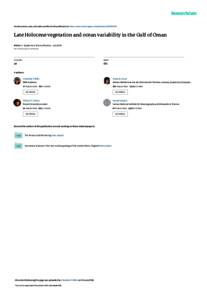Document
Late Holocene vegetation and ocean variability in the Gulf of Oman.
Identifier
DOI: 10.1016/j.quascirev.2016.05.010
Contributors
Publisher
Elsevier.
Gregorian
2016-07
Language
English
English abstract
Fossil pollen and dinocyst records in marine sequences are frequently combined to reveal the response of vegetation and ocean conditions to changes in both regional and global climate. In this study we analysed pollen and dinocysts within a clearly-laminated sediment core off the Iranian coast in the Gulf of Oman, an extremely data-poor area, to reconstruct climatic change during the Late Holocene (last 1900 years). The vegetation record from southern Iran indicates a replacement of savannah by desert formations at c. 910 CE, shortly after the Islamic invasion and the subsequent collapse of the Sassanid Empire. From c. 910 to 1145 CE, during the Medieval Climate Anomaly (MCA), the vegetation was heavily dominated by desert formations, such as Amaranthaceae, Caryophyllaceae, Asteraceae, Centaurea and Calligonum. In parallel, in the Gulf of Oman, the presence of Impagidinium paradoxum indicates a lack of freshwater discharge into the ocean around this time. The desert taxa of the MCA were subsequently replaced by savannah formations at c. 1145 CE, comprised mainly of Poaceae and Cyperaceae, corresponding to the Little Ice Age (LIA), indicating generally wetter climatic conditions. A sudden increase in Spiniferites ramosus (1-63%), at c. 1440 CE suggests an increase in the strength of the SW summer monsoon, with increased freshwater discharge into the ocean at this time. Our data indicate that over the past two millennia the NW Arabian Sea region has alternated between contrasting climatic conditions, with firstly a humid phase equivalent to the cultural period of the Sassanid Empire, a significantly drier climate during the MCA and a relatively wetter climate during the LIA. The mechanisms resulting in dry conditions during the MCA in the Middle East associated with the northward shift of the ITCZ and the intensification of the Indian summer monsoon may be similar to those causing the dry conditions which dominated the Early Holocene in the Near East. Our palaeoenvironmental proxy data support current observations that a globally anthropogenically-induced warmer climate is likely to lead to increased drought severity in the Middle East, putting additional stress on governments already struggling with poverty and social tensions.
Member of
ISSN
0277-3791
Resource URL
Category
Journal articles

